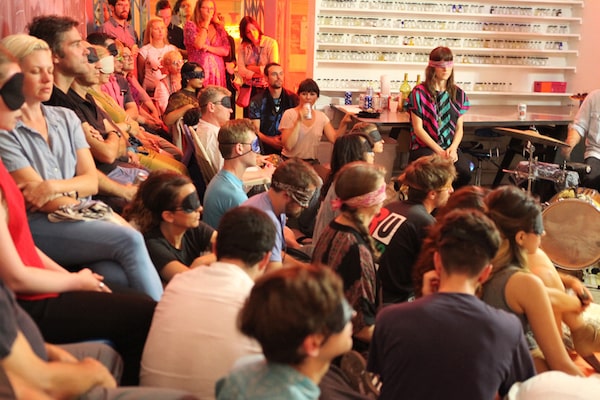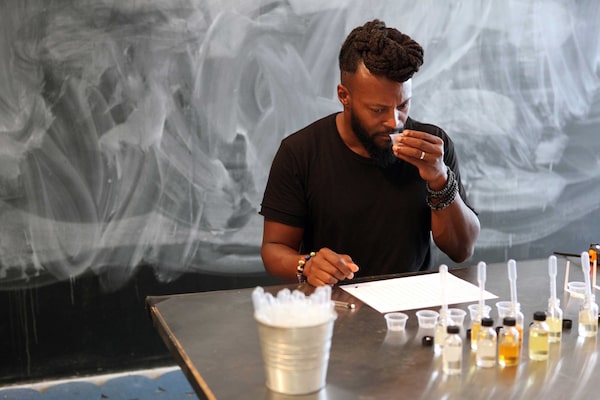
A performance at the Institute for Art and Olfaction in Los Angeles, which aims to help a broader range of aspiring perfume-makers enter the field.Institute for Art and Olfaction
The next time you take a whiff from that fragrant bottle on the bathroom counter, be mindful – it contains potent political juice.
Perfume doesn’t invite much scrutiny, but it should. As a luxury product previously reserved for the elite, the industry that creates it is arguably less diverse than other cultural spaces and faces familiar issues of gender and racial inclusion. Access to the centuries-old industry has been controlled by an elite few gatekeepers, typically white European (often French) men.
But emerging brands such as Dusita by Pissara Umavijani, a self-taught perfumer from Bangkok, Franco-Indian house Neela Vermeire Creations and Canadian Victor Wong and his acclaimed Zoologist Perfumes are challenging the insider nature of the business.
“There really has been no access [to raw materials and scent education] unless you’re of a certain profile – European, male and, typically, Caucasian,” says Saskia Wilson-Brown, founder and executive director of the Los Angeles non-profit Institute for Art and Olfaction (IAO). “That’s changing as the world changes and it’s something the Institute was set up to counterbalance but it’s slow going.”

The Los Angeles non-profit Institute for Art and Olfaction offers educational materials to aspiring perfume-makers.Institute for Art and Olfaction
A vocal activist and advocate of inclusivity in the perfume industry, Wilson-Brown aims to help a broader range of aspiring perfume-makers enter the field by offering educational resources and access to small quantities of raw materials through the IAO. In this way, she is attempting to disrupt the hierarchy of creation and democratize access to scent.
The IAO’s interest in equal access is as much about destabilizing corporate control of fragrance as it is about the decentralization of cultural homogeneity in perfume. Since opening five years ago in Los Angeles’s Chinatown, more than 12,000 people have attended drop-in sessions at IAO to play and practise with blending scents, and to attend hackathons, seminars and events such as perfumed film screenings and impromptu scented concerts. The idea is to expose artists, amateurs and the general public to aromatic materials and encourage working with scent as a creative practice.

The audience at a scented film screening.Institute for Art and Olfaction
“Before, perfume was like a secret world – fragrance was magic,” says Simon Tooley, founder of leading Canadian perfume retailer Etiket. “Now, people who have the passion, like a musician who has to make music, get to find out how, and maybe they are starting out by making horrid oils in their basement,” he says, “but eventually, they start getting better.”
Then there’s the push to broaden the perfume industry beyond France. “Patrimoine du parfum – the most tiresome three words in perfumery,” Wilson-Brown says, with a rueful laugh, of the way the French claim perfume as their cultural heritage product. “I just think, in general, as various voices are rendered ‘relevant’ from a Western perspective, Western perfumery will have to follow. We’re in a postmodernist time and we’ve got to adapt,” she says. “That’s the mission of the Institute – to get real. The French do not own perfume, sorry.”
Emerging perfumers are also modernizing the language around scent. Most of the fragrance wheel is grouped by type – such as citrus, floral and wood – with one glaring exception: “We’ve been trying to avoid the term ‘oriental,’ which is a traditional perfume industry term,” Wilson-Brown says. “People take umbrage, understandably. The mysteries of the Orient thing, there is so much wrong with that on so many levels.”
The move to rename, reclaim and potentially redefine this traditional fragrance family isn’t simple. “We’re dealing with probably a French man who gave this family its classification in the first place,” Canadian independent perfumer Dana El Masri says. “The problem is it’s very difficult to remove your fragrances from that classification because it’s been accepted for so long.”
Rather than rely on the outdated term, a recent IAO seminar described it as an exploration of “Shalimar-esque” scent notes, referring to Jacques Guerlain’s iconic perfume.
Wilson-Brown recounts bringing the issue up while giving a talk to master perfumers who scoffed and said the terms were just tradition, that they don’t mean anything. “But it does,” Wilson-Brown says.
To help address this, the IAO has introduced what it calls its scent and social ritual program, designed to de-exoticize various locations, starting with the Middle East and North Africa. Seminars explore a geographical and socio-political area through the lens of aroma, food, history and art.

Parfums Jazmin Saraï is handmade in small batches.
El Masri, who is also an interdisciplinary artist, will be the IAO’s perfumer in residence next month, sharing her diverse life experience with its members. Raised in Dubai, and now based in Montreal, El Masri, who is of Lebanese and Egyptian descent, studied at France’s Grasse Institute of Perfume. “I focus on scent, music and culture and what connects those three things,” El Masri says of her four-year-old brand Parfums Jazmin Saraï, all handmade in small batches.
Throughout May, El Masri will lead seminars on the history of materials and cultures, and on modern interpretations of aromatic practices in Iraq, Tunisia, Egypt, Lebanon, Syria, the UAE and Oman.
There’s been a lack of discourse on this particular topic, she says. “It’s only recently people have started having conversations about why the perfume term is problematic in the first place. And it’s this fetishization of the ‘Orient’ that really started with Opium.” She’s referring to Yves Saint Laurent’s sensation Opium, a spicy perfume the French fashion designer first marketed in 1977 with a bottle based on the traditional Japanese lacquered box, the inro, but it arguably dates back to Guerlain’s Shalimar of 1921.
“They used it as inspiration, but not actually to represent the cultures,” El Masri says. “What I’ve seen with oriental fragrances is that they’re either introduced by massive companies with no representation, or people riding the bandwagon to make money.”
Outsider and grassroots fragrance makers are challenging the colonial gaze’s accepted definitions. When Etiket’s Tooley and I spoke, he had recently returned from the annual artistic perfumery trade show Esxence in Milan, Italy, and says he’s seeing that increased diversity in the creative output. “In a row of 20 new, fascinating and beautiful young brands, what was exciting and interesting about them was that their concept isn’t about memory,” he says of the outsider approach. “It isn’t about existing perfume traditions, it’s, ’We want to start from something new.’ The world has changed.”